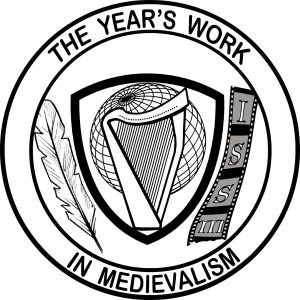Elisabeth Herbst Buzay
University of Connecticut
Medievalism takes on many forms in the contemporary world, but one of its most fascinating iterations occurs when it speaks simultaneously of past and present, when it pushes its audience to reconsider current topics, and when it brings medieval esthetics into modern forms. The two-volume French bande dessinée1 series L’Âge d’Or (2018-2020) by Cyril Pedrosa and Roxanne Moreil2 does just this when it invites readers into a marvelously-tinged (neo)medievalist3 tale depicted in sumptuous medieval-inspired illustrations. The story, in the form of a traditional epic poem, subverts the genre in order to reverse medieval tropes: the heroine-as-noble-knight dreams of a utopian world and strives to create such an ideal society in the kingdom whose inheritance is rightly hers, although she succumbs to the temptations of absolute power before being saved from her own corruption through the help of a “simple” villager. On another level this series is simultaneously a complex critique and questioning of our contemporary world and the issues of our times. In fact, this series is a particularly pertinent example of “medievalism today,” due to the explicit intentionality of its (neo)medievalism. Indeed, Pedrosa (illustrator and co-writer) and Moreil (co-writer) have explicitly expressed their intentions both in creating a (neo)medievalist work and of exploring contemporary issues and topics through this work, in particular questions of feminism, politics, and social engagement. As such, this series provides a framework through which to read similar works, allowing for wider conclusions to be drawn from this example.
Here, these ideas will be explored through multiple approaches, to draw conclusions concerning what this example of a contemporary (neo)medievalist work reveals. To do so, I will first explore how this series is an example of (neo)medievalism on several levels—that is, in terms of its genre, content, and visuality, a key aspect of the bande dessinée genre. Next, I will investigate how these works address questions of our times, as per the explicit intentions of the creators of this series, as they have explained in multiple interviews. Finally, in concluding, I will argue that this work, due to its intentionally (neo)medievalist approach and somewhat uniquely explicit authorial intentions, can serve as a model for understanding other contemporary (neo)medievalist works—and even more largely works of the genre known in French as “fictions de l’imaginaire” or “fictions of the imaginary”—that is, as means through which readers can explore our own contemporary world and the questions we ask ourselves.
Before delving into the (neo)medievalist natures of the Âge d’Or series, however, I will begin with a summary of the narrative. The heroine of the series, Tilda, is heir to the throne of the imagined country of Antrevers, and after her father’s death, she prepares to begin her reign, full of benevolent plans to improve the conditions of her people. However, a group of lords place her younger brother, Edwald, on the throne instead. Lines are drawn, and Tilda and her loyal companions flee, eventually acquiring a map for a treasure that Tilda’s father left for her. As they travel towards the treasure, Tilda grows physically weaker and emotionally crueler, a change which began when she touched the map. Meanwhile the country is in the throes of a battle between rebels who are fighting for the ideal of “l’âge d’or” (the golden age), a notion from a mysterious book, in opposition to Tilda’s brother and his supporters. By following the map, Tilda eventually acquires the treasure and a mysterious box that is capable of destruction when opened.
The second volume opens several years later, and we find Tilda at the head of an army, leading an endless siege against her brother’s forces. Tilda has become harsher and crueler, and no longer cares about her people or reason. But, when a “simple” peasant accidentally discovers the mysterious box and tells Tilda that there is a book in it—none other than the actual text called L’Âge d’Or—everything changes. By accepting the message of the book, Tilda is freed from the dark forces poisoning her, then allies her own forces with the rebels, and goes on to defeat her brother’s forces. As the series reaches its ending, Tilda ultimately brings the book, L’Âge d’Or, to the heart of the citadel, its rightful place. In a final scene, she is confronted by her brother, who stabs her and then opens the book, and thus Tilda simultaneously is killed and sets into motion the literal âge d’or (golden age). The series ends with the beginning of the true âge d’or, a utopian golden age that starts with the unleashing of the apparently natural and primordial roots of this era, which cause the literal destruction of the citadel through a fantastical growth of trees and plants, whose seeds, the text implies, have been present “[s]ince the dawn of the first day.”4
As the wide-sweeping nature of the narrative, as well as the visually striking appearance of the images in these bandes dessinées, suggest, these rich works can be examined through multiple lens. More specifically, I will examine how three specific aspects of these works—their genre, narrative content, and images—can be viewed as being (neo)medievalist.
First, the genre of these works is clearly (neo)medievalist in nature and is framed by a number of literary tropes that suggest that it is mimicking the form of the French medieval chanson de geste or epic poem. Indeed, the series’ creators confirm in an interview that they intended to write an épopée or epic.5 In particular, it is worth noting how the story of an individual—Tilda—is inextricably intertwined with the destiny of her country, as well as how questions of the collective dominate those of individual and how the topics of the feudal hierarchy and service are explored. If, as Ian Short writes in his introduction to La Chanson de Roland (The Song of Roland), “[t]he uniqueness of the epic is that it quenches the thirst for dreams that we all have and valorizes community in the duration and the continuity of its history,”6 then L’Âge d’Or, with its heroine’s ultimate self-sacrifice as the only way to save her country, is a perfect example. However, it should not be ignored that these literary tropes are also subverted in multiple ways, with a heroine taking the place of a hero and the continuity of the community eventually shown to require the destruction of the traditional notions of feudal hierarchy and service.
As is suggested by these references to events that occur within the narrative and that bolster the notion that the genre of this text exhibits (neo)medievalist aspects, I will next examine how the narrative content of these works does the same. Most obviously, this story takes place in a textual universe that is reminiscent of the Middle Ages, although it is a fictional world. This world is one without advanced technologies, and the story takes place in a kingdom with a feudal society. And yet, this is most definitely an imagined world, as is obvious from the fact that specific places like Antrevers, Roudene, and Ohman do not really exist. As the series’ creators, Pedrosa and Moreil, describe this textual world in an interview, “We are in a Middle Age of fantasy . . . An imaginary Middle Age. . . . A Middle Age of fiction that we invented, which resembles that of the tales of Perrault, or of Johan and Pirlouit’s Middle Age,”7 this last being a reference to a mid-twentieth century Belgian comic book series that takes place in a fantasy middle age. In other words, this narrative takes place in a consciously (neo)medievalist setting.
Furthermore, beyond the fictional universe itself, the narrative repeatedly exhibits (neo)medievalist characteristics. The opening scene of the series, for example, sets in counterpoint nobles riding to the hunt with peasants working in a field, before shifting to a small group of peasants who are speaking together of their hunger, then refer to an acquaintance who had his nose cut off for having poached on a lord’s lands. As the narrative continues, Tilda’s quest for the mysterious treasure parallels knightly quests in traditional French romances, another (neo)medievalist trait. Indeed, in his review of the first volume, philosopher, writer, and illustrator Gareth Southwell notes that the plot is a “medieval political intrigue,” although one that is accompanied by “other elements which give the story a more unique flavour.”8 The ongoing struggles of the peasants and townspeople to survive in the face of the payments they owe to the lords, in addition to these same groups of characters being required to serve their liege lords in times of battle, are just two more of the myriad ways in which this narrative reveals itself to be (neo)medievalist.
As a bande dessinée, the images that are an essential part of this medium cannot be neglected either, and the ways in which they tie into the (neo)medievalist traits of the series are manifold as well. Indeed, bande dessinée scholar Ann Miller emphasizes the importance of images in this genre when she terms it “a visual narrative art” that “produces meaning out of images which are in a sequential relationship, and which co-exist with each other spatially, with or without text.”9 What is notable in these works is how these images, in addition to picturing (neo)medievalist content—for example, characters’ clothing that is visually reminiscent of the Middle Ages, a busy court scene, or a walled city with half-timbered houses lining narrow streets—also incorporate medieval artistic techniques. Jessica Baldanzi, English professor and comics scholar, sums up these influences: “Pedrosa borrows not just settings, but also artistic techniques from medieval era paintings, tapestries, and illuminated manuscripts. Much as in medieval paintings, especially, visually flat characters are layered over similarly flat but intricately patterned worlds.”10 Indeed Pedrosa’s approach was well informed, for as he explains in a video about his drawing techniques for this work, “I had the impression that in order to narrate a medieval world, even if it’s a medieval world of a fairy tale, it needed embellishment, a golden thread.”11 He adds, “I also wanted to play with the embellishment’s decorative motifs, illuminated books.”12 Most striking, however, is his consciousness of the effects of using such techniques, for he explains, “when you use codes from another era, it helps to immerse the reader in another universe”13 This is certainly the case in this series.
Throughout these books, a variety of medieval-inspired techniques and practices are integrated into the illustrations. Indeed, before even opening the books, the covers (Figs. 1, 2) already demonstrate a number of these techniques.14 Both covers show dark scenes with limited color schemes (mainly blues and greens with pink and white highlights for the first, mainly reds and purples with golden highlights for the second) that center around a woman on a horse, who is surrounded by trees and vegetation. The first cover also has a lake reflecting the figures, while the second cover includes a castle and army tents in the background and a curious squatting figure in the foreground. In terms of technique, both covers display visually flat characters and backgrounds with detailed patterns. On the cover of the first volume, the flat characters overlay the intricate patterns of the trees, vegetation, and reflections in the lake (Fig. 1).
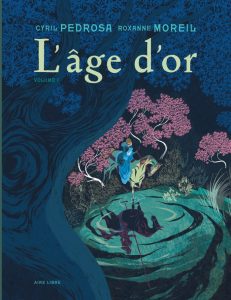
Figure 1: L’Âge d’Or – Volume I.
On the cover of Volume II, the flat characters appear in a scene with a flattened lack of perspective, making the detailed patterns of the warriors’ tents in the background seem curiously close (Fig. 2).
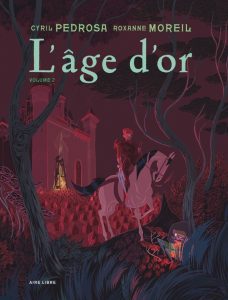
Figure 2: L’Âge d’Or – Volume II.
In both cases, these specific aspects are reminiscent of a variety of medieval paintings, tapestries, and illuminated manuscripts. In particular, the forest scene on the cover of Volume I and the vegetation-filled foreground of the cover of Volume II mirror the tiny details in the depictions of nature in the early 15th-century panel painting The Little Garden of Paradise (Fig. 3).15
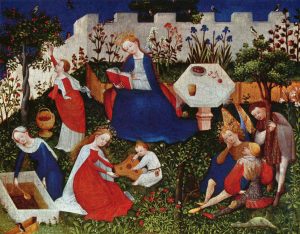
Figure 3: The Little Garden of Paradise.
Similarly, the closely packed leaves and trees that almost enclose the main character, Tilda, resemble the way in which the nobles in the 16th-century tapestry La Tenture de la Vie Seigneuriale: Le Bain (Fig. 4),16 are surrounded by leaves and trees.
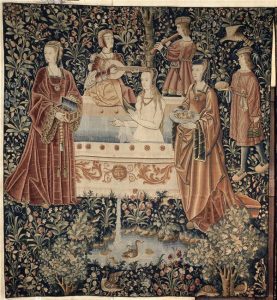
Figure 4: La Tenture de la Sie Seigneuriale: Le Bain.
The layout of both L’Âge d’Or covers also can be compared to the many medieval works with central figures on horses surrounded by natural motifs, such as in the image of Perceval arriving at the hermitage in a 15th-century illuminated manuscript (Fig. 5):17
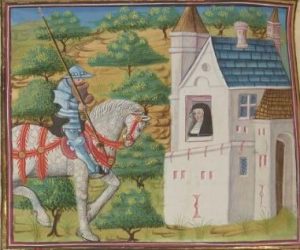
Figure 5: “Perceval à la Recluserie” in Le Livre de messire Lancelot du Lac.
This folio from the well-known 15th-century The Very Rich Hours of the Duke of Berry (Fig. 6)18 is also evoked:

Figure 6: Folio 8, “August,” The Very Rich Hours of the Duke of Berry.
In the case of the second cover (Fig. 2), these two examples are particularly pertinent as they include other secondary figures in addition to the figures on horseback, like the small human figure in the bottom right-hand corner of the cover, as well as the castle looming in the background. Furthermore, even the color choices and highlighting of the images resonate with medieval works, which were also created with limited colors and highlighted
important areas through distinguishing colors, especially in the case of illuminated manuscripts which did so using gold. Finally, although some aspects of these images use unrealistic colors—like the greenish-tinged horse (Fig. 1) or the red castle (Fig. 2)—and might at first seem to distinguish these works from their medieval precedents, as Christopher de Hamel points out, “One might imagine that the choice of colours in any picture would be obvious [. . .]. A medieval artist, however, was not necessarily seeking realism,”19 just like Pedrosa. In sum, then these artistic techniques, along with those of the narrative content and the genre, combine to create a convincingly (neo)medievalist work.
Having demonstrated the triple (neo)medievalist forms of this series, I will now explore how these books engage with current issues, despite their distance in time and space from our own contemporary world. As with the genre, content, and visual aspects of these works, Pedrosa and Moreil are explicit about their intentions in creating this work as a reaction to and reflection of contemporary issues. These issues can be grouped into three categories: political struggles, the effects of power on individuals, and how to move forward in a fractured world. But these works also engage with feminist notions and subtly reference environmental concerns.
Political struggles are the underlying basis of the narrative of the Âge d’Or series. Tilda struggles to fulfill her father’s last wishes that she inherits his kingdom, but when her younger brother challenges her position, an ongoing battle ensues, pitting the kingdom and each siblings’ supporters against each other. At the same time, issues of political class emerge as the problems inherent in the feudal system become apparent: poor peasants are being taxed and do not have enough to eat; lords fight with each other to gain territory and riches; and the lord-vassal relationships requiring loyalty are tested. The creators, who began writing the first volume in 2016 in a France in which satisfaction with then-President François Hollande was low, intentionally created a work reflecting this political climate.20 They also had the goal of echoing “the growing defiance of the French towards the political class and towards the corruption that access to power entails.”21
This question and critique of how gaining power can lead to corruption is also an evident part of the series. Not only does the narrative hinge on the siblings’ political struggles, but as they gain power, each slowly evolves into a monstrous form resulting from their growing desire for power: By the end, Edwald entirely transforms into an inhuman creature with pointy teeth (e.g., 2:169), while through the two volumes, Tilda changes from a generous, innocent young woman, into a harsh, tortured, and physically “stained” leader at her lowest point. As Jérôme Lachasse notes, “[i]n the second volume, Tilda sees blood-colored spots appear on her body. Her father had similar spots on his deathbed. ‘They are the stigmata of a usurped, illegitimate power that devours and destroys them – in addition to destroying the world around them,’ comments Pedrosa.”22 Again, the creators intentionally introduced these notions as a reflection of contemporary concerns with political corruption and the lack of proper action by authorities and political leaders. In the textual world, as in the real world, corrupt or power-hungry leaders not only destroy themselves, but also the world around them. Lachasse further emphasizes this by adding: “In L’âge d’or the people lose confidence in their leaders after a series of bad decisions. A situation that echoes contemporary France, where millions of citizens feel themselves to be abandoned in the middle of the Covid-19 pandemic. As if L’âge d’or had become a metaphor for this strange year. The illustrator is conscious of this.”23
Ultimately, however, the larger question emerging from this series is how citizens can react and move forward in a fractured world in which the current social system does not seem to work. Again, within these works, this is clear, for the feudal system of the textual universe is failing, is full of corruption, and abandons its people, who struggle to survive. But within this society, besides those forced to fight for one or another of the battling siblings, there is a group of rebels who believe in the mysterious possibility of a “golden age” for which they are willing to fight—and eventually, they triumph. When this golden age begins with the destruction of the citadel and the death of Tilda and her brother, it is the destruction of this broken system that occurs. Less a critique of a specific female leader (Tilda), whose self-sacrifice follows the epic genre’s sacrifice of the individual for the greater societal good, or a suggestion that post-medieval societies are utopic, there is a more general message being suggested, that broken systems do not have to be endured, but can be destroyed, and that new and better systems can exist once those broken systems are eliminated. Furthermore, as the closing pages reveal, differences of class and imbalances of power are no longer present in this golden age. Speaking of the series, Pedrosa explains, “The people are reacting to a system that no longer suits them, in which they no longer want to live—even if they do not have visibility about what another world or another social agreement could be. They only know that they do not want it [the system] anymore and that they want to destroy it.”24 And while he acknowledges that the book does not necessarily provide an answer for readers’ parallel situations in the contemporary world, the series’ goal was to “‘render audible a political speech that is difficult to make heard at this time—and to do it in a project for the general public, without dealing a blow to people.’”25 In other words, by couching these questions in the series, readers could consider their own parallel situations in the contemporary world.
Two last aspects of how this series engages with contemporary issues are those related to feminism and environmental concerns. The former is addressed through the creators’ development of an intentionally strong female protagonist. In the first volume, strong female characters are also seen in what Southwell describes as “the community of women warrior-scholars”26 who live in the forest. In our era that is struggling for gender equality and in which the #MeToo movement is taking place, strong female characters and their battles are a timely inclusion. Additionally, the fact that the commencement of the golden age occurs due to the literal destruction of the previous society through the growth of trees and plants resonates with current issues of climate change and environmental concerns. While this topic is more subtly touched upon than other contemporary issues, it would be remiss not to note it, as there is a clear link showing that the golden age is an era in which nature is prospering.
Throughout this series, then, we can see that contemporary issues are raised over and over, despite being couched in explicitly (neo)medievalist settings. This combination suggests the benefits of such a pairing. Lachasse emphasizes this in his piece which begins “tales often permit [us], better than any other type of story, to understand the world around us.”27 Furthermore, Pedrosa and Moreil point out that they specifically chose a (neo)medievalist setting as it allowed them to both explore a world with strikingly evident political disparities, while simultaneously being a believable setting for a political fable.28
To conclude, this genre of work is particularly suited to exploring contemporary issues and this reading of the Âge d’Or series can be seen as a framework through which to examine other (neo)medievalist works. For the first aspect, this paper shows how the clear inequalities of the social systems often inherent to (neo)medievalist works lend themselves to discussions of political and social inequalities. Moreover, as Pedrosa points out, because feudal societies did indeed end and evolve into newer systems, this gives readers hope that the inequalities within their own contemporary social systems could, one day, similarly end and evolve into more equal ones. In addition, (neo)medievalist works, like other “fictions of the imaginary,” allow readers to view worlds that are temporally distant from their own. As such, this distance provides a different perspective, one that often permits a more clear-eyed sense of situations that can be hard to navigate when one is in the midst of them, yet another reason for which (neo)medievalist works are a useful lens through which to view contemporary issues.
This leads to the hypothesis that because Pedrosa and Moreil’s explicit intentions provide confirmation of their intent to use a (neo)medievalist work for the purpose of addressing contemporary issues, this work can serve as a framework through which to view other (neo)medievalist works whose creators may not so explicitly reveal their intentions. While contemporary issues are certainly not the only meaning of this specific work, and while they may not always be a part of every (neo)medievalist creation, this exploration suggests that such readings can and should be considered. For, as with the Âge d’Or series, (neo)medievalist works can and do provide complex, detailed, and deep means of addressing the concerns of our contemporary world.
- I prefer to use this French term, as opposed to the English “comics” or “comic strip,” due to its meaning and connotations. As defined in History and Politics in French-Language Comics and Graphic Novels, “‘Une bande dessinée’ translates literally as ‘a drawn strip (or band).’ [. . .] As has often been noted, it has an advantage over the English term, ‘comics,’ insofar as the French-language term contains no suggestion that the material is comic or funny. It also draws attention to the way that the art is generally produced (through drawing) and the strip-like form in which it has often been created, and thereby to its sequentiality (like the term ‘comic strip’). However, this last aspect of the term can also be misleading, because for decades the overall page layout (as opposed to the strip) has been an essential aspect of the art of many cartoonists and comics.” See Mark McKinney, “French-Language Comics Terminology and Referencing” in History and Politics in French-Language Comics and Graphic Novels, ed. McKinney (Jackson: University Press of Mississippi, 2008), xiii.
- Cyril Pedrosa and Roxanne Moreil, L’Âge d’Or – Volume I (Marcinelle: Éditions Dupuis, 2018) and L’Âge d’Or – Volume II (Marcinelle: Éditions Dupuis, 2020).
- In this article, the term “(neo)medievalist” will be used as these works encompass aspects of both of the terms “medievalism” and “neomedievalism,” particularly given the varied ways in which each of these notions can be defined. More particularly, on the one hand, these books are a reimagining of the medieval period and directly adopt and adapt historical medieval notions (political, artistic, literary, etc.), but on the other hand they are also doing that work which Carol L. Robinson and Pamela Clements define neomedievalism as doing, that is, “‘consciously, purposefully, and perhaps even laughingly reshaping [themselves] into an alternate universe of medievalisms, a fantasy of medievalisms, a metamedievalism.’” See Robinson and Clements, “Living with Neomedievalism” in Studies in Medievalism XVIII: Defining Medievalism(s) II (Cambridge: D. S. Brewer, 2009), 55-75, 56). For these reasons, the term “(neo)medievalism,” embracing this multiplicity, seems most appropriate for these multivalent works.
- “Depuis l’aube du premier jour…,” Pedrosa and Moreil, L’Âge d’Or, 2:178. All translations from French are my own.
- Cyril Pedrosa and Roxanne Moreil, “The Golden Age: An Interview with Creators Roxanne Moreil and Cyril Pedrosa,” Europe Comics, April 17, 2019, https://www.europecomics.com/golden-age-interview-cyril-pedrosa-roxanne-moreil/.
- “Le propre de l’épopée est d’étancher la soif de rêve qui est celle de chacun et de valoriser la communauté dans la durée et dans la continuité de son histoire,” Ian Short, “Introduction” in La Chanson de Roland, 2nd edition (Paris: Librairie Générale Française, 1990), 6.
- Pedrosa and Moreil, “The Golden Age: An Interview.”
- Gareth Southwell, “‘The Golden Age’ by Cyril Pedrosa and Roxanne Moreil,” review of The Golden Age, Garethsouthwell.com, accessed February 1, 2022, https://garethsouthwell.com/the-golden-age-cyril-pedrosa-and-roxanne-moreil/.
- Ann Miller, Reading Bande Dessinée: Critical Approaches to French-language Comic Strip (Bristol: Intellect Books, 2007), 75.
- Jessica Baldanzi, “‘The Golden Age: Book One,’ by Roxanne Moreil and Cyril Pedrosa,” review of The Golden Age, Commons Comics, December 11, 2020, accessed November 13, 2022, https://www.commonscomics.com/2020/the-golden-age-book-one-by-roxanne-moreil-and-cyril-pedrosa/.
- Cyril Pedrosa, “Making of: The Golden Age (In Cyril Pedrosa’s Studio),” Europe Comics, April 17, 2019, accessed November 13, 2022, https://www.europecomics.com/golden-age-making/.
- Pedrosa and Moreil, “The Golden Age: An Interview.”
- Pedrosa and Moreil, “The Golden Age: An Interview.”
- Cover art is digitally available via the publisher DP Dupuis (https://www.dupuis.com/seriebd/l-age-d-or/14267); for high-quality individual digital images, see Vol. I (https://bdi.dlpdomain.com/album/9791034730353-couv-M700x1200.jpg) and Vol. II (https://bdi.dlpdomain.com/album/9791034732647-couv-M700x1200.jpg).
- Upper Rhenish Master, The Little Garden of Paradise (Paradiesgärtlein), ca. 1410-1420, mixed techniques on oak board, Städelsches Kunstinstitut und Städtische Galerie (Städel), Frankfurt, https://en.wikipedia.org/wiki/Paradiesg%C3%A4rtlein#/media/File:Meister_des_Frankfurter_Paradiesg%C3%A4rtleins_001.jpg.
- La Tenture de la Sie Seigneuriale: Le Bain, ca. 1500-1525 (first quarter, 16th century), tapestry (Dutch), Musée de Cluny – Musée National du Moyen Âge, Paris, https://www.musee-moyenage.fr/collection/oeuvre/la-vie-seigneuriale.html.
- “Perceval à la Recluserie,” 15th century, attributed to Walter Map, painting on vellum, Manuscrits Français 111 folio 244v, Bibliothèque Nationale de France, within “Le Livre de Messire Lancelot du Lac” in La Quête du Saint Graal as part of La Mort d’Arthus, https://gallica.bnf.fr/ark:/12148/btv1b10502007v.
- “August,” ca. 1411-16, Limbourg brothers (Paul, Johan, Herman) for Jean I, Duke of Berry, painting on vellum, Musée Condé (Chateau Chantilly) MS 65, folio 8, within Très Riches Heures Du Duc De Berry, https://chateaudechantilly.fr/en/collection/the-tres-riches-heures-du-duc-de-berry/.
- Christopher De Hamel, The British Library Guide to Manuscript Illumination: History and Techniques (Toronto and Buffalo: University of Toronto Press, 2001), 74.
- “Right in the middle of the pre-electoral period, there was political disillusionment everywhere. Cyril and I talked a lot, then, about political reengagement or how to rediscover a space as a citizen that would be a little more satisfying. We made these debates the common thread of our story.”
“En pleine période pré électorale, il y avait une désillusion politique de toute part. Cyril et moi discutions beaucoup, alors, sur le réengagement politique ou la façon de retrouver une place de citoyen qui soit un peu plus satisfaisante. Nous avons fait de ces débats le fil rouge de notre histoire.” Aurélia Vertaldi, “La Case BD: L’Âge d’Or Ou l’Utopie en Majesté,” Le Figaro, September 12, 2018, accessed November 13, 2022, https://www.lefigaro.fr/bd/2018/09/08/03014-20180908ARTFIG00013-la-case-bd-l-age-d-or-ou-l-utopie-en-majeste.php.
- “qui a voulu faire écho dans L’Âge d’or à la défiance grandissante des Français envers la classe politique et à la corruption qu’entraîne l’accès au pouvoir,” in Jérôme Lachasse, “‘L’Âge d’Or’, Saga Médiévale aux Accents Très Contemporains, sur la Corruption du Pouvoir,” BMFTV, November 6, 2020, https://www.bfmtv.com/people/l-age-d-or-saga-medievale-aux-accents-tres-contemporains-sur-la-corruption-du-pouvoir_AN-202011060040.html.
- “Dans le deuxième tome, Tilda voit apparaître sur son corps des taches couleur sang. Son père avait des taches similaires sur son lit de mort: ‘Ce sont les stigmates d’un pouvoir usurpé, illégitime qui les dévore et les détruit – en plus de détruire le monde autour d’eux’, commente Cyril Pedrosa,” Lachasse, “L’Âge d’Or’, Saga Médiévale.”
- “Dans L’Âge d’or, le peuple perd confiance dans les leaders après une série de mauvaises décisions. Une situation qui fait écho à la France contemporaine, où des millions de citoyens se sentent abandonnés en pleine épidémie de Covid-19. Comme si L’Âge d’or était devenu une métaphore de cette année étrange. Le dessinateur en est conscient,” Lachasse, “‘L’Âge d’Or’, Saga Médiévale.”
- “Le peuple est en réaction à un système qui ne lui convient plus, dans lequel il ne veut plus vivre – même s’il n’a pas de visibilité sur ce que pourrait être un autre monde, un autre accord social. Ils savent uniquement qu’ils n’en veulent plus et vont le détruire.” Lachasse, “‘L’Âge d’Or’, Saga Médiévale.”
- “rendre audible une parole politique difficile à faire entendre en ce moment – et dans un projet grand public, sans rien assener aux gens.” Lachasse, “‘L’Âge d’Or’, Saga Médiévale.”
- Southwell, “‘The Golden Age’.”
- “Les contes permettent souvent, mieux que n’importe quel autre type de récit, de comprendre le monde qui nous entoure,” Lachasse, “‘L’Âge D’or’, Saga Médiévale.”
- “‘The Middle Ages is a period in which inequalities are very striking, and so it is conducive to creating a clear political ideal,’ explains Roxanne Moreil.
For the authors, situating the story in as enchanting a period as an imagined Middle Ages, allowed them to make audible, even credible, their political fable: ‘The reader knows that this feudal world disappeared, so talking about a utopia at that time makes it possible. It is not questionable for the reader in the space of the book. The reader knows that the people are right to hope, since one day they will no longer be serfs in the service of a lord,’ elaborates Cyril Pedrosa.”“‘Le Moyen-Âge est une période où les inégalités sont très frappantes, propice à créer un idéal politique clair,’ explique Roxanne Moreil.
Pour les auteurs, situer le récit dans une période aussi enchanteresse qu’un Moyen-Âge imaginé, a permis de rendre audible, voire crédible leur fable politique: ‘Le lecteur sait que ce monde féodal disparaîtra, donc parler d’utopie à ce moment-là la rend possible. Elle n’est pas contestable pour le lecteur dans l’espace du livre. Le lecteur sait que les gens ont raison d’espérer, car un jour ils ne seront plus les serfs au service d’un seigneur,’ précise Cyril Pedrosa.” See Vertaldi, “La case BD: L’Âge d’Or.”

